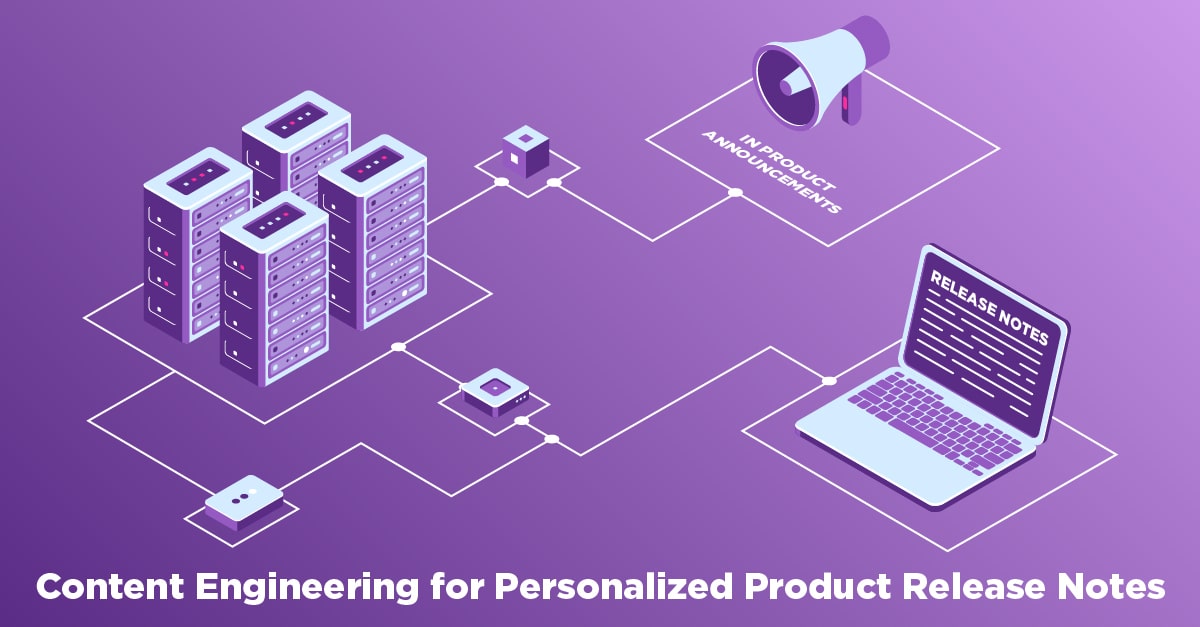

The Challenge
A global software vendor with a vast portfolio of cloud software products needed to deliver more personalized, timely, and relevant release notes of upcoming product changes in a continuous implementation, continuous delivery (CI/CD) environment to both internal and external end-users. The delivery and structure of release notes to product administrators and customers made the content hard to find and less relevant to external client organizations’ product administrators and individual customers in their product instances. The CI/CD environment for content delivery presented the challenge of consistent releases and updates to system operations, increasing the likelihood of disruptions occurring when introducing the latest change.
Customers struggled to understand product changes and reported they did not receive enough information to prepare their organization for continual product changes, resulting in diminished customer trust in the software vendor.

The Solution
As part of this end-to-end advanced content engagement, EK defined the Current and Target State of content management and the content model while accounting for new content authoring processes, the software vendor’s unique brand voice, and their long-term content operations vision. EK focused on developing a comprehensive content model supporting structured and componentized release note content, improving user experience (UX) interactions, and leveraging the organization’s taxonomy to filter the content for more personalized delivery.
EK facilitated a series of focus groups across the software vendor’s various teams of content authors, marketing, technical SMEs, and executive leadership to define the current state of content authoring processes and content management and ensure cross-team alignment on the target state for authoring, content management, and structured content model design. EK’s team collaborated with the SMEs at the client organization and the vendor of the solution’s CMS when designing the high-level solution architecture through a content engineering and content strategy lens, leveraged the client’s existing tech stack, and enabled the implementation of a structured and componentized content model in a headless CMS environment. EK carefully considered the stakeholder requirements in our delivery of the following:
Holistic Solution Architecture Design – EK collaboratively developed a solution architecture for data integration and data flow between existing systems in the client organization’s technology ecosystem. The solution design also supports structured content authoring, publishing processes, and multi-channel contextualized delivery for three specific delivery channels.
Content Operations Enhancement – EK leveraged human-centered design practices when developing content governance around authoring processes that streamlined authoring workflows and when contributing to change management planning for author training. EK’s efforts included developing and designing a structured content model and taxonomy design that enabled content reuse in multiple personalized contexts without duplication.
Content Personalization Strategy – EK’s consultants defined a content strategy that accounted for the complexities around content, process, and personalization requirements gathered in stakeholder sessions to transform a legacy content model into structured content components. EK’s structured content design for In-product release notes provides comprehensive and personalized information about each new feature or fix within the specific product version purchased by an enterprise customer in addition to delivering content about relevant features within an individual subscriber’s product version.
The componentized content model and newly enhanced metadata definition enabled tailored multi-channel delivery of product release notifications and contextualized in-product announcements. The comprehensive content model also supports a product administration interface that provides comprehensive and personalized information about each new feature or fixes relevant to the customer’s specific instance. EK’s team developed the high-level solution architecture for data integration and data flow between the content management system and the internal environments of the vendor’s portfolio of products to support new authoring and publishing processes.

The EK Difference
EK consultants leveraged their vast knowledge and expertise in advanced content management practices to solve the client’s content and system design challenges, producing authoring, modeling, and delivery architecture design requirements as well as content operation processes. EK’s expert consultants conducted multiple interviews, facilitated collaborative working sessions, and engaged in supplemental conversations to align disparate stakeholders across various product and content teams. The outcome of this human-centered design approach enabled our consultants to holistically understand stakeholders’ needs and bridge gaps across stakeholders’ diverse goals, and the company’s long-term vision.
EK’s approach to stakeholder alignment merged personal stakeholder interaction that enabled the development of a comprehensive content strategy with a technical solutions architecture that supported recommendations. EK’s technology experts leveraged existing system architecture processes and data flows in our end-to-end delivery of content engineering, content strategy, and content architecture design in an effort to reduce technology cost savings and training burden.
EK collaboratively worked with the client when defining the distinct internal authoring experience, external end-user experience, and content experiences necessary for specific delivery channels. The outcome of EK’s end-to-end engagement provided the client with the right content structure, system architecture, and content strategy to successfully deliver personalized and relevant content promptly to end-users within a continuous implementation, continuous delivery (CI/CD) environment.

The Results
EK’s content design and implementation guidance enabled personalized and consistent delivery of product release notifications to the software vendor’s numerous product administrators and customers at the point of need through distinct delivery channels.
Content governance and editorial guidelines ensure authoring processes and experiences are now intuitive, and flexible. The structured content model for componentized content and enhanced metadata streamlined content creation processes to be more efficient, by providing accurate references to related content and components for reuse in the authoring environment to increase content authors’ awareness of existing content and reduce rework.
The new componentized content model supports customized and contextualized end-user experiences, which improved overall customer engagement. Since implementation of the multi-channel delivery strategy, structured content model, and system architecture integration, the software vendor saw a 300% increase in product release notification engagement. Customers now only consume relevant product release notifications and announcement content in a more timely manner, so they have increased time to prepare for changes and mitigate organizational risk. End-users now have the option to quickly reference content within product applications or the comprehensive product documentation web page for changes, and now interact with enriched information on each change, how to prepare for it, who it impacts, and when to expect the change.
